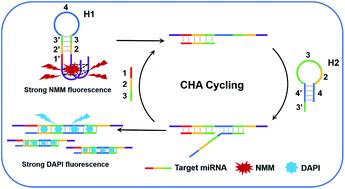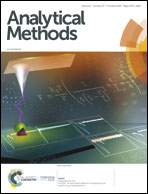Label-free and ratiometric detection of microRNA based on target-induced catalytic hairpin assembly and two fluorescent dyes†
Abstract
MicroRNAs (miRNAs) play critical roles in gene regulation and are related to human diseases such as cancer, and thus the sensitive and accurate detection of miRNAs is of great significance. In this work, we report a novel label-free fluorometric and ratiometric miRNA sensing method. We develop two complementary hairpin DNA probes (H1 and H2) for the catalytic hairpin assembly (CHA) signal amplification and employ two fluorescent dyes (NMM and DAPI) as signal reporters. Target miRNA binding to H1 can initiate the CHA and target the recycling process, making conformational changes in H1 and H2 and accelerating the hybridization between them. Significant fluorescence reduction of NMM and fluorescence enhancement of DAPI can be observed during the process, which enable sensitive and ratiometric detection of miRNA. Notably, we apply this method to measure cancer-related miRNA-21 and miRNA-125b, and our results highlight the general utility of our approach to detect miRNAs, with sub-picomolar low detection limits. We also apply this method in cell lysate to demonstrate its potential for application in miRNA analysis in biological samples.



 Please wait while we load your content...
Please wait while we load your content...